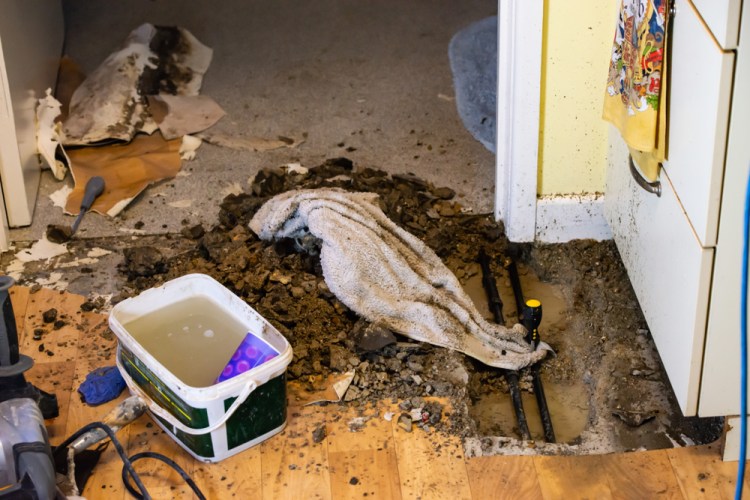Maine received a one-two punch of flooding this winter. In December, torrential rain led to historic floods on the Androscoggin and Kennebec Rivers, devastating residents and businesses and even claiming lives. Then in January, coastal Maine was rocked by a full moon storm, where an ocean surge during an unusually high tide ripped down structures and tossed sea wall boulders like pebbles.
These events were a reality check: Maine is not immune to the destructive weather unleashed by our warmer global climate. Matthew Romano, Vice President and Flood Specialist with Monarch Northeast, said there’s a common, yet false, sense of security that goes with not being in a high-risk zone.
“Technically, everybody in America is in a flood zone,” he said. “And news stories are showing people struggling with the aftermath of these storms because they did not know their risk or options.”
According to some estimates, less than 1% of Maine home and business owners have a flood insurance policy. When compared to the national average of 4%, it’s clear that business and residents need to be doing more to protect themselves, their property and their families.
Know the basics
The most important thing to know is that, yes, contrary to popular belief, you can take out a flood insurance policy on any home or business in Maine. While you won’t have success trying to buy a policy as a storm is bearing down, there are no special enrollment periods, and most policies will take effect within 30 days of purchase.
The reason any property qualifies is because the state participates in the National Flood Insurance Program, or NFIP, which is underwritten by the federal government. Premiums for this policy will vary based on the assessed risk for your property, but the maximum payouts are $250,000 for the structure and $100,000 for contents for a home, and for a business, $500,000 for structure and $500,000 for contents.
However, if you are unable to open your business due to flooding or damage, NFIP will not cover productivity loss. For that, you will have to turn to a private market policy, which can also increase maximum payouts into the millions.
Understand your flood zone
Like Romano said, every property is at some risk of flooding, but it’s good to know exactly where your property stands. Flood zones are determined by FEMA, the Federal Emergency Management Agency. You can look up data at fema.gov/flood-maps.
Don’t make assumptions
Even if you think you’re covered, double check. After our winter storms, local business owners were quoted in the news regretting that they did not know the fine print of their insurance policies.
In high-risk zones, your lender will require you to carry flood insurance, however Romano suggested that working with a full-service insurance broker is the best way to make sure you are totally covered. “Start out with maximum needs,” he said. “Like your building, its contents, any business interruption, and then work with your agent to come up with limits that are affordable.” He said he’s seen problems arise because people are just buying without putting the proper thought into what they are purchasing. “Having a knowledgeable person is key,” he said. “A good local team, like Hub International, will be able to walk you through policies, ask you great questions that uncover your needs and help you figure out what you can afford for premiums versus deductibles.”
Quantify your risk capacity
Justifying the cost of a premium is the hardest part of buying almost any insurance policy. “It’s the one item in your monthly bills that you hope to never use, and might never use,” said Romano. “But if you need it, you are very grateful for it.”
To understand what’s at stake, he suggested estimating what exactly you can afford to pay for out of pocket for damages. For people with access to wealth, significant savings, or high profit margins at their business, investing in the premium might not be worth it to them. People operating on thinner margins likely cannot make five- or six-figure fixes at once, so finding an affordable premium might be paramount.
Minimize damage, whether insured or not
With or without flood insurance, you will want to prevent as much damage as possible when you know a weather event is on the way. If you do have insurance, check if your policy has a stipend to help pay for mitigation expenses.
Sandbags can seal up doorways and cracks or you can use them to redirect water flow on an incline. Keep them filled and on hand, as acquiring emergency supplies when a storm is on the way will be more difficult.
Check your systems. In high or medium risk areas, FEMA recommends having a professional install check-valves to prevent water from backing up into your home’s plumbing. If you already have a sump pump, make sure it is working and consider having a backup. For your electric system, make sure your circuit breakers are clearly marked for each area of your home.
Get everything off the floor. Romano suggested imagining how much damage just one inch of standing water could do to your home and belongings. Roll up rugs and move objects from the bottom shelves or lower cabinets onto counter or tabletops. If you use your basement for storage, invest in sturdy shelves or, at the very least, reclaim wood pallets to get as much as you can off the floor. Put important documents into a water and fireproof container.
Take “before” pictures. This is good advice for any imminent disaster. Having a contemporary record of your home or business’s contents and state of maintenance will be key to maximizing your claims and/or applying for FEMA assistance after a storm.
Have more questions? Need to re-examine your policy? How about a new one altogether? Contact your broker today or reach out to Hub International to get started.

Comments are not available on this story.
Send questions/comments to the editors.


